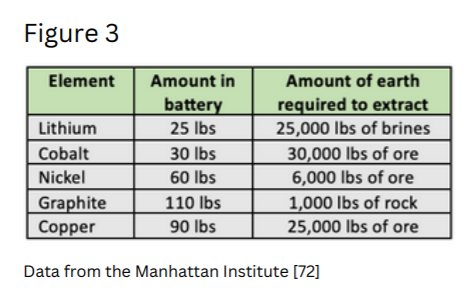Kristin Walker at the (American Consumer Institute) has published research analyzing the carbon cost of so-called green technology. She breaks down the details for the big three – Wind, Solar, and EV Batteries – and details the emissions cost of the so-called magic that makes these things possible.
Often left out of the discussion is the emissions-heavy and environmentally destructive processes involved in producing wind, solar, and the batteries for EVs. The life cycle (from cradle to grave) of each one carries its own carbon footprint and global impact. And while the consumption phase may be relatively free of emissions, the creation and retirement stages are energy intensive, potentially harmful, and in some cases completely devastating.
She says that she wants to have,
[A]n honest conversation on the environmental realities of so-called green energy, because so often these realities are buried. We need to have this piece of the puzzle when creating and
implementing policies that affect a significant portion of our economy, consumers, and the well being of the human race. Are these strategies our best option? Are they worth the monumental risks involved?
It’s a good read, not too technically dense, and unlikely to sway the zealots, but reasonable Americans might be surprised at how much brown and black it takes to make a little bit of green. Take EVs, a popular whipping horse, on these pages. The Elites want to end the joys of affordable personal transportation, and EVs are a step in that direction. Kristin isn’t grinding any political axes, but she is delivering details that anyone of average intelligence will see as contradicting the science and the goal. Kristin writes,
The essential minerals of a battery are lithium, cobalt, nickel, graphite, and copper. Just like solar panels, energy-intensive mining is required to extract, produce, and manufacture these components. A typical EV battery weights 1,000 lbs. Collectively, 90,000 lbs of rock/ore are involved just to extract the amount needed for one battery. But to access each ton of ore, anywhere from 3 to 20 tons of earth must be removed. This averages out to about 500,000 lbs of earth removal per car battery.
[citations removed]
In addition to the minerals displayed in Figure 3, and the quantity of earth extracted, each battery will contain about 400 lbs of steel, aluminum, and plastic components.

Additionally,
Synthesization of the materials needed for production requires heat between 800 to
1,000 degrees Celsius, a temperature that can only cost-effectively be reached by
burning fossil fuels.
You can’t make or process the things required without fossil fuels, and lots of them, which exposes the lie of Western elites who claim they can end fossil fuel use when what they mean is end affordable use and easy access by you.
The research includes many of the facts we’ve shared here in the past: rare earth metal mining and lack of environmental control leading to the destruction of Indigenous people’s land and water resources; generational damage to drinking water; birth defects, cancers, respiratory diseases, loss of livestock, fish, and other flora and fauna; and the intense amount of clean water required for extraction, production, or processing. Emissions resulting from the use (charging, vehicle wear and tear, and repairing and replacing infrastructure worn out more quickly due to their excessive weight). Resource scarcity, sole-source foreign suppliers, life expectancy, replacement cost, and waste disposal.
Only about 5% of EV batteries are currently recycled, and of those, only some of the material is reusable. The process is carbon-intensive and environmentally dangerous.
For every ton of battery processed for recycling, approximately four tons of are emitted during the smelting process.[93] This is known to also generate carbon tetrafluoride, a compound that is estimated to be 6630 times more potent than CO2.
The 95 percent of batteries that don’t get recycled are slated to end up in landfills, where
unfortunately, their hazardous components can leak into the soil and groundwater.
Landfills are also a major contributor of greenhouse gas emissions.
Whatever the energy transition is about, it does not involve lowering emissions or going green.
clearing-the-air